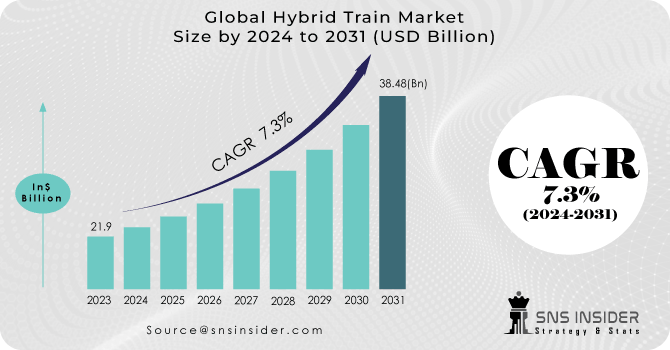
Fueled by growing environmental consciousness and stricter emission regulations, the Hybrid Train Market is poised for significant growth. The market is expected to register a robust CAGR of 7.3% from 2024 to 2031, reaching a valuation of USD 38.48 Billion by 2031.
A Greener Tomorrow for Railways
Railway transportation plays a vital role in moving people and goods across vast distances. However, traditional trains contribute to air pollution by emitting nitrogen dioxide, carbon dioxide, and particulate matter. Hybrid trains, which combine electric or alternative fuel sources with diesel engines, offer a more sustainable solution. The increasing demand for greener modes of transport, coupled with supportive government regulations, is propelling the Hybrid Train Market forward.
While the high cost of overhaul and maintenance can act as a restraining factor, the environmental benefits of hybrid trains are undeniable. Additionally, government initiatives promoting hydrogen-powered trains, like the Indian Railways’ “Hydrogen for Heritage” project, are fostering an eco-friendlier railway sector and paving the way for market expansion.

Hybrid Train Market
Get a Free Sample PDF Copy of the Latest Research @ https://www.snsinsider.com/sample-request/1221
Top Key Companies Profiles:
- Kawasaki Heavy Industries
- CRRC
- Alstom
- General Electric
- Hyundai Rotem
- Bombardier
- Construcciones Y Auxiliar De Ferrocarriles (CAF)
- Wabtec Corporation
- Siemens
- Hitachi
- Toshiba
Driving Factors and Growth Opportunities
Stringent emission regulations are pushing train manufacturers to develop cleaner technologies. Leading companies like Alstom, Bombardier, Siemens, and Wabtec Corporation are actively investing in alternative fuel-powered trains.
Hybrid trains offer a significant advantage for freight companies: reduced operating costs. By utilizing electric, fuel cell, CNG, or LNG technologies, hybrid trains can cut fuel and maintenance expenses by nearly 50% compared to conventional diesel trains. Furthermore, retrofitting existing diesel locomotives with battery systems is a cost-effective alternative to purchasing entirely new locomotives. This approach not only lowers the upfront investment for railway operators but also reduces greenhouse gas emissions.
For instance, Deutsche Bahn (DB) announced in 2022 that it would retrofit 100 diesel-electric trains with hybrid technology, aiming to reduce onboard weight and improve overall efficiency. This trend highlights the growing market for diesel retrofitting and creates demand for energy storage systems.
Market Segment Analysis
By Propulsion:
- Electro-Diesel
- Hydrogen-Powered
- Battery Operated
- Gas Powered
- Solar Powered
By Operating Speed:
- Less than 100 km/hr
- 100-200 km/hr
- More than 200 km/hr
By Application:
- Passenger
- Freight
Segment Analysis: Dominance and Growth Potential
The Passenger Hybrid Train segment currently holds the largest market share and is projected to maintain its dominance throughout the forecast period. Several factors contribute to this segment’s leadership:
Hybrid trains offer a cost-effective option for transporting passengers, making them particularly attractive for cities implementing new rail infrastructure projects to address traffic congestion and enhance connectivity.
As urbanization accelerates, the demand for efficient and reliable passenger transport solutions also rises. Hybrid trains address this need by providing a comfortable, dependable, and safe travel experience with reduced emissions compared to traditional diesel trains.
Meanwhile, the Hybrid Trains with Speeds Above 200 KM/H segment is expected to witness significant growth in the coming years. Advancements in hybrid technology and train traction systems are pushing operational speeds beyond the 200 km/h mark. This segment caters to the need for faster travel times and reduced congestion on high-speed rail lines. The development of a 250 km/h hybrid train by CRRC Qingdao Sifang Locomotive & Rolling Stock Co., Ltd (Sifang) exemplifies this trend and paves the way for the future of high-speed hybrid rail travel.
Enquiry or Share Your Questions If Any Before Purchasing This Report@ https://www.snsinsider.com/enquiry/1221
Impact of Russia-Ukraine War on the Hybrid Train Market
The ongoing conflict between Russia and Ukraine has disrupted global supply chains, impacted the availability of raw materials and hindered the transportation of critical railway equipment. This disruption can potentially slow down the development and deployment of hybrid trains. Additionally, the war has diverted resources and scientific expertise away from research and development endeavors, potentially delaying advancements in hybrid train technology. Furthermore, the economic uncertainties arising from the conflict might lead to reduced investments in infrastructure projects and new train acquisitions, including hybrid trains.
Impact of Economic Slowdown on the Hybrid Train Market
Governments might allocate fewer resources towards infrastructure projects and public transport initiatives during an economic downturn. This could lead to a decline in investments in hybrid train technologies. Economic downturns often force individuals and businesses to prioritize essential spending. This could lead to a decreased demand for passenger travel, potentially impacting the market for passenger hybrid trains.
Europe Is At The Forefront Of The Hybrid Train Market
The region is home to prominent railway manufacturers like Alstom, Siemens, Hitachi Rail, and CAF, all actively developing and deploying hybrid train technologies. Europe enforces strict environmental regulations, prompting railway operators to seek cleaner alternatives like hybrid trains to comply with emission standards and contribute to a greener environment.
Many European governments offer financial incentives like subsidies and grants to promote the adoption of hybrid and electric trains, making these technologies more accessible for railway operators.
For instance, in August 2023, Alstom unveiled a new battery-powered train in Germany, a testament to Europe’s commitment to sustainable rail transportation. Additionally, the UK government’s plan to phase out diesel-only trains by 2040 reinforces Europe’s position as a leading market for hybrid train technologies.
Key Takeaways: Invest in the Future of Rail
- Gain a comprehensive understanding of the market’s projected growth trajectory to identify lucrative investment opportunities.
- Make data-driven decisions by delving into the performance of various hybrid train segments, including passenger and high-speed trains.
- Identify key players and their strategies to gain a competitive advantage in the market.
- Stay ahead of the curve by understanding the latest technological advancements and market trends shaping the future of hybrid trains.
- Gain in-depth knowledge about the performance of the Hybrid Train Market in key regions like Europe and Asia Pacific.
Get Access to The Full Market Report@ https://www.snsinsider.com/reports/hybrid-train-market-1221


